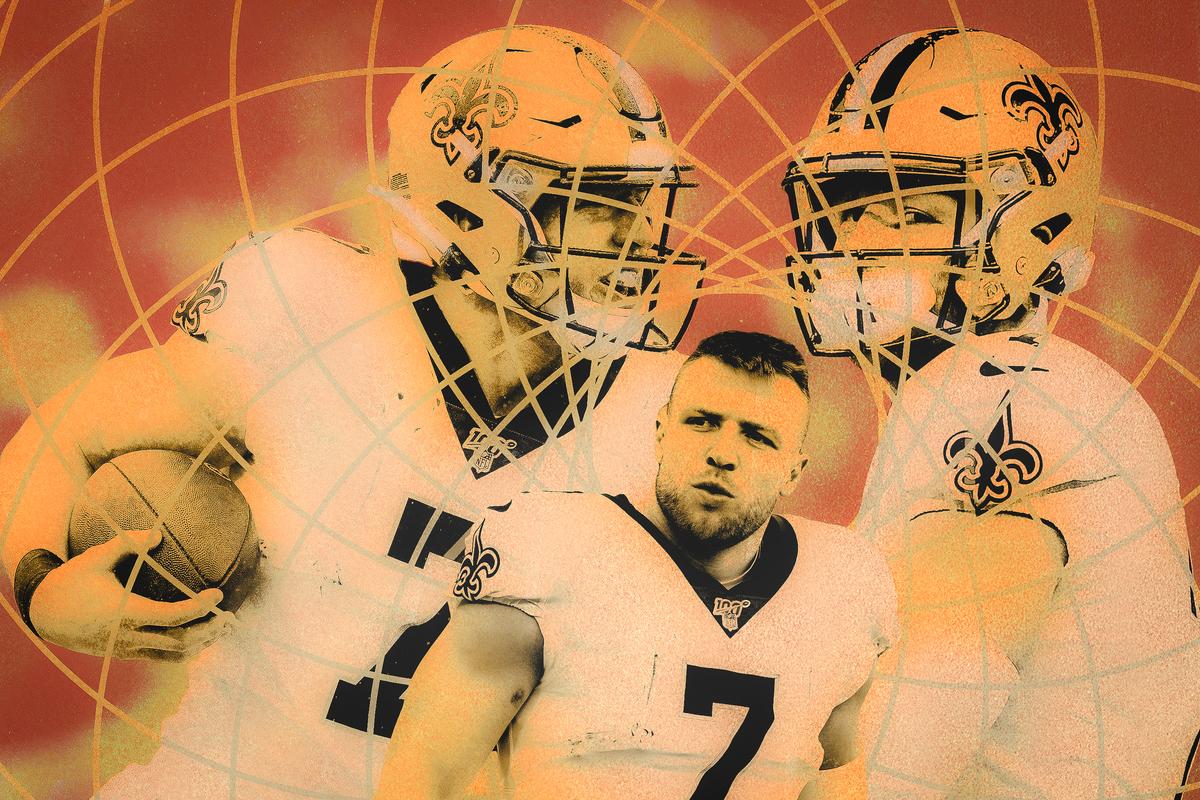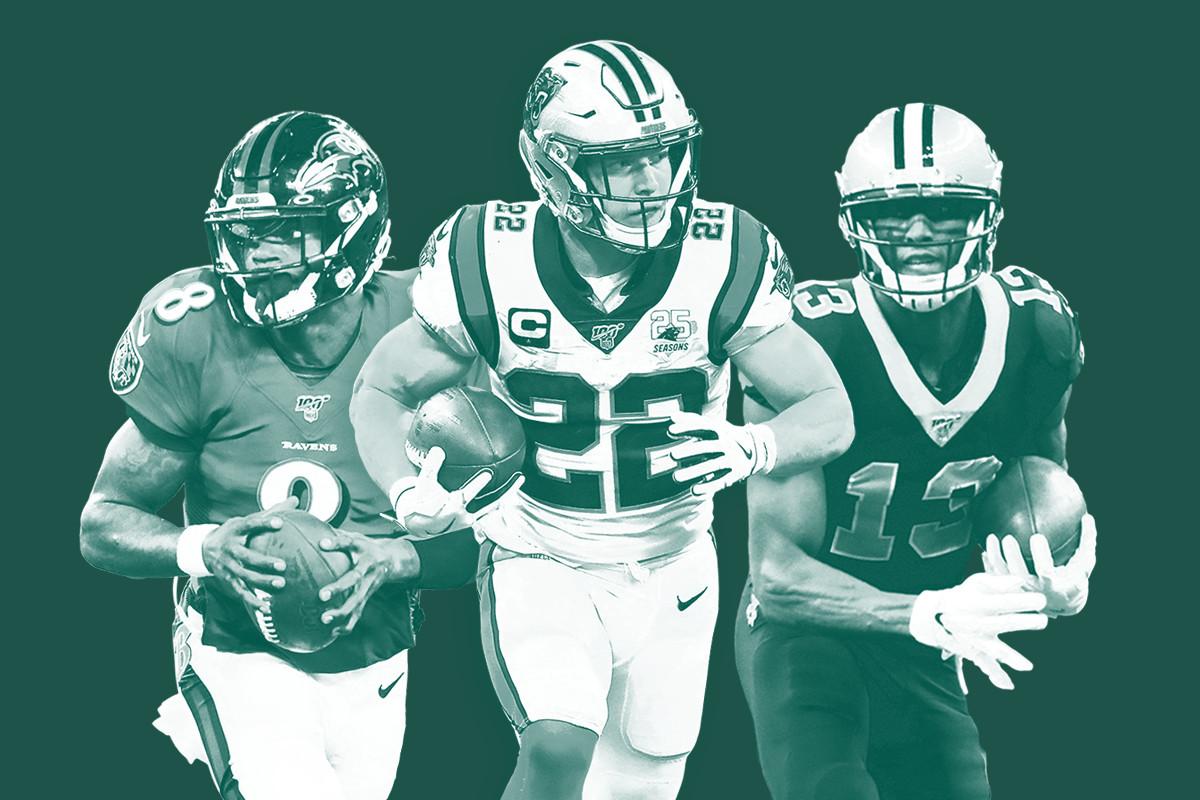
In an NFL offseason headlined by Patrick Mahomes’s record-setting 10-year, $503 million contract extension, it’s no surprise Taysom Hill’s two-year, $21 million pact with the Saints flew relatively under the radar. Sure, Mahomes’s new deal includes eye-popping numbers and could change the way teams structure contracts forever―but with $16 million in guarantees hinting at an expanded role, Hill’s extension was, to me, just as intriguing.
The Saints’ big-money commitment to a soon-to-be 30-year-old backup who’s thrown exactly 13 regular-season passes in his career was mystifying, especially considering the team added Jameis Winston with a near-vet-minimum deal a few weeks later. But the deal implies the Saints have something bigger in store for the Swiss Army knife―and visions of how New Orleans could utilize Hill immediately started to pop into my head. With Drew Brees entrenched as the Saints’ starter for at least another year, Hill will have to wait until 2021 or beyond to prove he’s the team’s true heir apparent at quarterback, but in the meantime, it will be fun to see what head coach and play-caller Sean Payton has up his sleeve for utilizing the team’s überathletic playmaker. From wildcat runs, jet sweeps, and downfield wheel routes to the potential development of two-quarterback formations and plays, here’s a look at how the Saints could get their money’s worth from Hill in 2020.
Hill’s path from undrafted free agent to special teams ace to gadget-play maestro to supposed successor-in-waiting to Drew Brees has been a winding one. A three-star recruit out of high school, Hill first spent two years in Australia on an LDS church mission before enrolling at BYU. With the Cougars, he quickly showed off his extraordinary athleticism on the gridiron—he threw a touchdown pass on his first play from scrimmage, in fact—and accounted for eight touchdowns (four passing, four rushing) before a knee injury cut his freshman season short. That was pretty much the story of Hill’s college career; the dual-threat QB totaled 43 passing touchdowns and 32 rushing scores in 37 games over five seasons in Provo, but suffered four separate season-ending injuries (that knee injury in 2013, a broken leg in 2014, a Lisfranc fracture in 2015, and a hyperextended elbow in 2016). A then-26-year-old Hill went undrafted in 2017, signed on with the Packers as a free agent, and despite impressing in preseason action, was released during roster cut-downs. New Orleans snatched him up on waivers.
Hill contributed as a special teamer for the Saints as a rookie and saw his role expand to a sort of jack-of-all-trades in 2018: He got reps as the team’s primary kick returner, as a punt gunner, as a running back, and as a blocking tight end, among other duties. The team expanded on those responsibilities in 2019, and Hill’s role―and overall impact―grew dramatically down the stretch. After averaging a 16 percent snap rate on offense through the first 12 weeks of the season, Hill’s playing time more than doubled over the team’s final five games to a 35 percent snap rate. But he wasn’t doing much real quarterbacking with those snaps. Hill attempted just six passes in 2019, completing three of them for 55 yards. He was more active as a runner and a receiver, tacking on 19 receptions for 234 yards and six scores through the air and 27 rushes for 156 yards and a touchdown on the ground. His seven total touchdowns ranked third on the team behind Michael Thomas and Jared Cook (both with nine).
Hill’s utility as a do-it-all playmaker was on full display in the team’s playoff loss to the Vikings. In that 26-20 defeat, he alternated lining up as a de facto quarterback, running back, fullback, receiver, and tight end, finding the end zone on a 20-yard catch while becoming the first player in postseason history to tally at least 25 receiving yards, 50 rushing yards, 50 passing yards, and one tackle in the same game. That performance―paired with his subsequent contract extension―could offer a glimpse at how the Saints plan to deploy their unique offensive weapon in 2020.
As Payton noted after the deal was announced, there’s no point in having Hill stand on the sideline with a clipboard. “Taysom’s earned this opportunity to be our two [backup quarterback], but he’s also earned the opportunity to play and help us win football games as a one. Whether you call him a tight end, a receiver, a specialist, a quarterback, he’s going to play. He’s too good of a football player.”
He might be too highly paid to not be a big part of the team’s plans, too. Whether you consider him a true backup quarterback or more of a utility player, the fourth-year veteran now ranks among the top-paid players at just about every position he plays, at least according to average annual value ($10.5 million). His deal ranks 20th among quarterbacks (and second among backups) by that measure, is comparable to what the Seahawks are paying receiver Tyler Lockett ($10.6 million in AAV, 21st leaguewide), matches that of the Browns’ Austin Hooper for the second-richest tight end contract in the league (at least pending George Kittle’s official extension), and would rank sixth among all running backs (behind only Christian McCaffrey, Ezekiel Elliott, Le’Veon Bell, David Johnson, and Derrick Henry). Not bad for a guy who never played more than 50 percent of his team’s offensive snaps in any game in 2019.
He may not have played a full-time role for New Orleans, but Hill showed an ability to do a little of everything for the team; in addition to excelling on special teams, Hill ran routes from typical receiver alignments, both on the outside and in the slot, and was comfortable both catching the football in traffic and picking up yards after the catch.
He had no issue aligning as the team’s tight end or H-back, too.
And at 6-foot-2 and 221 pounds, Hill proved to be a load to tackle with the ball in his hands. His power and elusiveness as a runner showed up on screen plays:
And his natural ability as a ballcarrier―his vision and ability to squeeze through a condensed defense―showed up on this sweep:
That combination of traits, along with his top-level speed, was on full display when he was asked to line up in the backfield as a running back. Payton gushed over Hill’s athleticism when the deal was announced. “I don’t think people realize how fast he is,” he said. “He’s probably one of the three or four fastest guys on the team.”
On this play, he even went out and played the de facto fullback role, running a wheel route up the sideline for a big gain.
Now, there are plenty of NFL players capable of lining up at multiple spots in an offense. There are fewer, though, who regularly take the place of the team’s starting quarterback. And there’s really just one who comes in to take the ball away from a future Hall of Fame passer: That’s Hill. I’ll admit I would typically find myself cringing when Payton would send Hill in to take snaps away from Brees, and it’d baffle me even more when he’d actually drop back to make a pass. That was a rare occurrence, but for what it’s worth, Hill did create a few explosive plays with his arm.
The real value in those pass attempts, though, was strategic in nature. Showing that Hill can make those throws helps to keep defenses honest and make them think twice about dedicating all their resources to the line of scrimmage when Hill is in the game. The very real threat of a quarterback pass can help lighten boxes just enough for Hill to do some damage as a runner. The Saints used him in several different QB-centric run schemes, including quarterback-power, where he demonstrated vision and decisiveness in the open field.
He showed off some of his speed and elusiveness on read-option plays, too:
In his career, Hill has broken 19 tackles on 31 zone-read runs, an incredible rate that adds evidence to the idea that he’s more than just a gimmick; he’s a legitimate playmaker. Further, Hill was also extremely valuable (and just about automatic) in short-yardage situations for New Orleans in 2019. Deployed in a variety of manners (as a direct-snap quarterback, as a running back, and as a fullback), he ran the ball seven times on third or fourth down and fewer than 2 yards in 2019 and produced six first downs (including one in which he broke free and scored a touchdown) on those plays.
But the above examples are really just the tip of the iceberg for how New Orleans could utilize Hill in 2020. With Winston manning no. 3 QB duties on gamedays, the Saints could, at least in theory, play Hill as a normal, near-every-down-type skill player―rotating him in at receiver, running back, tight end, or fullback. The Saints could even tinker with more two-quarterback formations, where both Brees and Hill are real threats to throw the ball. Teams have dabbled with these types of plays throughout the league’s history. The Ravens utilized Lamar Jackson and Joe Flacco on some two-quarterback plays in 2018. The Patriots have used former college quarterback Julian Edelman on a handful of double throws. And the Eagles’ iconic Philly Special was a crucial, sort-of two-quarterback play in Super Bowl LII in which former high school quarterback Trey Burton took a toss, reversed the field, and hit Nick Foles for a touchdown.
Will New Orleans help blaze a new trail and make those types of plays a major part of its offense? Time will tell. Eagles quarterbacks coach Press Taylor suggested last summer that these two-quarterback plays could be the NFL’s next big trend. “I think at some point, one of the big things will be having multiple people on the field who can throw the ball,” he said. “You’ve seen the Philly Special, you’ve seen all different versions of double passes. … I just think that can be something that’s pushing the envelope.”
Those comments helped fuel theories that Philly will use second-round rookie quarterback Jalen Hurts in some of the same ways New Orleans has used Hill. Hurts was one of the most dynamic and versatile quarterbacks in college football over the past four years and could certainly play a role as a short-yardage/red zone rusher and sometimes passer. The Raiders are another team to watch for that type of experimentation. Las Vegas offensive coordinator Greg Olson noted recently that they’ve got a similar plan in mind for third-round rookie Lynn Bowden, who was a receiver and wildcat quarterback at Kentucky.
But the Saints are still likely to be the trendsetters. For starters, Payton’s already proved he has the necessary chutzpah to take the ball out of his superstar starter’s hands and give it to, well, literally anyone else. That’s not an easy sell for coaches to make to both the media and fans. Additionally, Payton―who has compared Hill to Steve Young―is on the record that he sees the versatile playmaker as a real option for the team’s long-term replacement for Brees (which The Athletic’s Jay Glazer reports is more than just coachspeak or a smoke screen). There’s no substitute for live game reps, after all, and getting Hill more involved this year as a passer would give the team a chance to evaluate its (potential) quarterback of the future.
Ultimately, though, Payton must walk the fine line between innovating and getting too cute as a play-caller. Hill is an incredibly versatile player and has a fun highlight reel, but when it comes down to brass tacks, the Saints offense is just plain good―whether Hill’s out there or not.
Put another way, Payton should probably keep the old maxim “If it ain’t broke, don’t fix it” front of mind in 2020. The Saints, who finished fourth in Football Outsiders’ DVOA last year and return the vast majority of their key starters, may be best served by simply continuing to have Hill do what he does best. That could mean a big boost in snaps playing the running back, receiver, tight end, and fullback spots; he’s proved he belongs on the field and is an explosive runner, natural pass catcher, and terrific blocker. It also might mean an expanded package of plays for the team’s crucial third- and fourth-down situations, where Hill’s skill set as a running quarterback makes New Orleans’ offense difficult to defend. As PFF’s Seth Galina points out, when Hill ran the ball from behind center (as the de facto QB) on those key short-yardage plays, he posted an 83 percent success rate. But outside of those plays, the team is probably better off letting Brees handle the offense: On all of Hill’s other designed quarterback runs (not on third- or fourth-and-short), his success rate dropped to just 26 percent.
Still, it’s unquestionable that Hill brings value to the Saints in multiple ways. For starters, he makes things easier for New Orleans in how it constructs its 47-player game-day roster (one more than the typical 46 game-day actives in normal seasons), where his ability to play multiple positions on offense and special teams allows coaches to dress an extra offensive lineman or defender as needed. He provides tangible value as a dynamic runner, receiver, and as an infrequent thrower, and he is a near-unstoppable short-yardage threat.
Perhaps more importantly, Hill offers an incredible intangible value as well: He changes the way teams must prepare for―and defend―the Saints offense. It forces opponents to commit to drawing up counters to the types of specialty packages the Saints roll out for Hill, which eats into valuable practice time that could have otherwise been spent trying to stop one of the best quarterbacks of all time. And when he’s on the field, opposing teams must be ready for just about anything, whether that means a QB run or a deep out or a double throw … or anything in between. The bottom line is that while Hill’s two-year, $21 million deal might sound steep for a part-time player, Hill makes things tougher for opponents whether he plays 15 snaps or 50 snaps.


